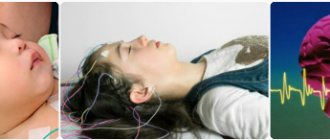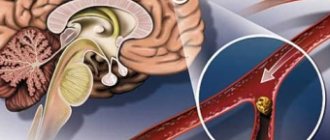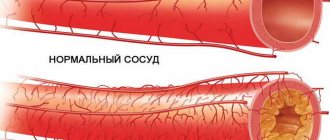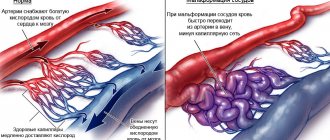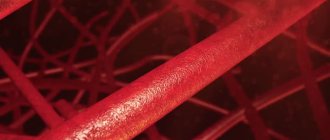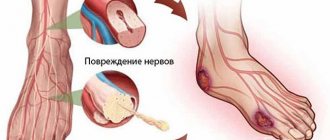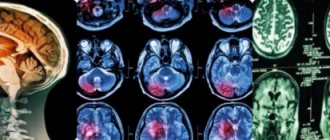Irina Baranova
Cardiologist
Higher education:
Cardiologist
Kuban State Medical University (KubSMU, KubSMA, KubSMI) Level of education - Specialist 1993-1999
Additional education:
“Cardiology”, “Course on magnetic resonance imaging of the cardiovascular system”,
Research Institute of Cardiology named after. A.L. Myasnikova
"Course on functional diagnostics"
NTsSSKh them. A. N. Bakuleva
"Course in Clinical Pharmacology"
Russian Medical Academy of Postgraduate Education
"Emergency Cardiology"
Cantonal Hospital of Geneva, Geneva (Switzerland)
"Therapy course"
Russian State Medical Institute of Roszdrav
Contacts
Maintaining a healthy state of the blood vessels in the brain is a prerequisite in order to feel like a full and active person longer, have a good memory and protect yourself from headaches. Fortunately, brain vessels can be treated and many effective medications have now been developed and are successfully used in practice.
Treatment of cerebral atherosclerosis with medications can reduce the size of plaques that cause the disease and relieve vascular spasms. In addition, some tablets can improve blood characteristics and give it the ability to resist the formation of blood clots. An important rule: the sooner complex treatment is started, the faster and more favorable the outcome can be expected with the opportunity to return to a full-fledged lifestyle.
Features of drug treatment of cerebral atherosclerosis
Atherosclerosis is a vascular disease in which blood flow is impaired due to loss of elasticity of the walls and the formation of cholesterol deposits on them. It affects almost all major arteries in the body. Most often, the pathology affects the most important organ – the brain. Unlike other organs, it is very sensitive to any changes. Even minor loss of functionality can lead to severe tissue hypoxia and ischemic stroke.
The disease is quite dangerous and can be asymptomatic for a long time. For timely treatment, it is important to pay attention to minor manifestations:
- dizziness;
- fatigue and low performance;
- noise in ears;
- causeless headache;
- changes in blood pressure.
Only correct diagnosis and complex therapy can completely cure the pathology in the early stages, and in advanced cases, eliminate unpleasant symptoms and prevent severe complications such as stenosis and obstruction of the arteries, brain hypoxia, encephalopathy, stroke and death.
Atherosclerosis of cerebral vessels is treated under the constant supervision of a doctor; self-medication is strictly prohibited.
Plaques in cerebral atherosclerosis
Mechanisms and reasons for development
The mechanism of development of atherosclerosis is quite complex, but the process can be simplified as follows:
- deposits of lipids (fatty substances) occur on the walls of large arteries;
- in place of the formed fat spot, fibrous connective tissue grows;
- the formed plaque becomes denser due to the accumulation of calcium salts in it.
Formations on the walls of blood vessels protrude inward, so obstacles form in the path of blood flow. As plaques grow, a significant narrowing of the lumen occurs, so blood enters the organ that feeds the damaged vessel in insufficient quantities.
If atherosclerosis of the cerebral arteries develops, then the brain tissue suffers from lack of blood circulation.
Causes of the disease
Scientists and doctors have been trying for many years to understand what reasons lead to the development of this terrible disease. Unfortunately, it was not possible to obtain an exact answer to the question posed.
Atherosclerosis is a multifactorial disease, that is, the causes of its development are diverse. The main factors that increase the risk of getting sick are:
- age-related changes, most patients belong to the older age group;
- hereditary factor, predisposition to the disease is transmitted at the gene level;
- increased blood clotting;
- hormonal disorders (thyroid disease, diabetes);
- high blood pressure.
In addition, the development of the disease is facilitated by not the most healthy habits of modern people. The following reasons can be cited that increase the risk of getting sick:
- addiction to smoking tobacco;
- love for fatty and sweet foods, leading to obesity;
- low mobility.
Groups of drugs for atherosclerosis
An integrated approach is very important in the treatment of vascular pathologies. There is no single cure for cerebral atherosclerosis. To cleanse blood vessels of lipid deposits and normalize blood circulation, a number of drugs are needed that have a versatile therapeutic effect . The selection is made from the following medication groups:
- statins, fibrates, sequestrants – reduce cholesterol levels, inhibit its production, and promote the removal of lipid accumulations;
- antiplatelet agents, anticoagulants – prevent blood thickening and the formation of blood clots, reduce clotting and platelet aggregation;
- vascular drugs (calcium antagonists, nicotinic acid) - dilate blood vessels, reduce blood pressure in hypertension, prevent brain hypoxia, strengthen vascular walls;
- analgesics and antispasmodics – relieve vasospasm, help with migraine pain, improve microcirculation in the brain;
- nootropics, sedatives – improve mental activity, performance, memory, attention, normalize sleep, eliminate anxiety, restlessness, emotional instability;
- vitamins, herbal medicines - improve metabolism in brain tissue, blood circulation, saturate cells with useful substances.
Based on the diagnosis and clinical picture, the neuropathologist individually draws up a therapeutic regimen.
Stages of progression of atherosclerosis
Features of the pathogenesis of atherosclerosis
At the first stage of the development of the disease, lipids are deposited on the inner wall of the arteries - the intima. The muscle layer is not involved in the pathological process. Over time, fats begin to accumulate, and since there are few antioxidants in the intima, lipid oxidation processes begin.
These processes occur especially quickly in diabetes mellitus, since persistent hyperglycemia significantly impairs the functioning of the inner lining of the vessel.
Subsequently, leukocyte migration occurs. Monocytes play a major role in the process of atherogenesis. In the inner lining of the vessel, the monocyte becomes a macrophage and begins to absorb fats deposited in the intima. Xanthoma (foam) cells in atherosclerosis are nothing more than lipid-filled macrophages.
Some of the xanthoma cells are able to leave the artery wall, which somewhat slows down the progression of the disease, but if the intake of lipoproteins exceeds their removal by macrophages, an atherosclerotic plaque is formed as a result.
Due to necrosis of part of the xanthoma cells, a cavity is formed in the plaque, connective tissue grows, which later calcifies. In the later stages of atherogenesis, blood clots often form on the surface of plaques.
The main drugs for the treatment of cerebral atherosclerosis
The basis of therapy for atherosclerosis is cholesterol-lowering agents, anti-thrombosis agents, and vascular medications. Most often prescribed:
- "Lovastatin"
Tablets for cerebral atherosclerosis with lipid-lowering effect. Suppress the formation of cholesterol in the body, reduce the concentration of lipoproteins. Take 40 mg once a day for a long time . They are well tolerated, sometimes causing dyspepsia, myopathy, and headache. They have no strict contraindications, except for individual intolerance.
- "Pravastatin"
A good remedy for atherosclerosis to reduce fat in the blood. It acts similarly to Lovastatin. Prescribed simultaneously with diet in the amount of 10-40 mg per day . Skin allergies may occur due to long-term use. Contraindicated in liver diseases, pregnancy and lactation.
- "Traykor"
A drug from the group of fibrates that reduce total cholesterol, triglyceride levels, and also prevent platelet aggregation. Take 1 tablet once a day. It is taken with caution and has a number of contraindications and side effects.
Diagnosis of vascular atherosclerosis using MRI
- "Clopidogrel"
The best remedy for atherosclerosis with an antiplatelet effect. Reduces the ability of platelets to stick together, which is an important prevention of stroke. Prescribed 1 tablet per day for a long course, the maximum effect occurs after a 3-month course . Contraindications: acute bleeding, allergies to drug components, liver failure. Adverse reactions - digestive disorders, increased bleeding.
- "Corinfar"
A vascular drug from the group of calcium channel blockers. It has a strong hypotensive effect, dilates blood vessels, improves heart function and blood microcirculation, and slows down the development of atherosclerotic disorders. Take 1-2 tablets twice a day . Not used for hypersensitivity, acute infarction, aortic stenosis, unstable angina and aortic stenosis.
- "Nikoshpan"
Medicine based on nicotinic acid. Expands and eliminates spasms of cerebral vessels, reduces the content of lipoproteins in the blood, improves carbohydrate metabolism. It is prescribed three times a day, one tablet at a time . Side effects – rapid heartbeat, dizziness, dermatitis. Contraindicated for prostate hypertrophy, lactation and glaucoma. Cannot be used for heart, kidney or liver failure.
These drugs for cerebral atherosclerosis are prescribed by the attending physician and cannot be taken independently.
Treatment of cerebral atherosclerosis
Vasodilation and improved blood circulation in the brain
The head may hurt due to oxygen starvation and insufficient blood supply to the brain. Improve energy metabolism in cells and blood supply to the brain. For these purposes, the attending physician may prescribe calcium antagonists. Drugs from this group help the arteries relax, have a positive effect on the tone of the veins and the entire process of oxygen supply to the brain.
Blood flow increases, oxygenated blood begins to actively flow to the brain. Modern developments can even be used to correct disorders in all vessels of the body. A doctor's appointment is required, as side effects are possible. These drugs are already being developed by third generation pharmacists. They are distinguished from later ones by a longer impact, increased accuracy and a reduction in negative effects and risks. Among the most effective in this group were medications such as Cinnarizine and Nimodipine.
What is Cinnarizine
Cinnarizine can have an extremely positive effect on cardiac and cerebral circulation, improve microcirculation, increase the ability of red blood cells to be more plastic and reduce blood viscosity, which is very important to prevent the formation of blood clots. Tissues become resistant to hypoxia. The product effectively relieves spasms.
The drug is most often tolerated well, apart from moderate drowsiness and gastrointestinal disorders. However, the dosage and method of administration in order to avoid side effects should be prescribed by a doctor, taking into account all contraindications and individual nuances of the patient.
Treatment of the disease with fibrates
Fibrates are important drugs in therapeutic methods against atherosclerosis. According to the mechanism of action, they all mainly contribute to reducing the amount of cholesterol and triglycerides by increasing a special enzyme. Such medications are combined with a special vitamin - nicotinic acid. The products are well absorbed and have good bioavailability.
Effectively regulate lipid metabolism, improving the activity of lipoprotein lipase. In many ways, they have proven to be even more effective than statins, but both differ in their individual characteristics. Fibrates (as well as most other drugs for the treatment of this type of disease) require additional diet to lower cholesterol levels as much as possible. Fibrates can be of various types - clofibrates, bezafibrates, gemfibrozil, fenofebrate, etc.
The doctor will prescribe medication depending on the situation and the level of cholesterol in the blood serum. Also, in case of atherosclerosis, taking vitamins (nicotinic acid) can have a powerful strengthening effect on blood vessels. All medications can be in the form of tablets, capsules and solutions. Often the name of the drug and its key active ingredient will be the same.
Symptomatic drugs for cerebral atherosclerosis
Atherosclerotic changes are accompanied by a number of unpleasant manifestations. Patients complain of migraine-type headaches, poor sleep, low performance, and constant fatigue. To eliminate painful symptoms and improve well-being, you can take:
- "Amigrenin"
Prescribed as an anti-migraine agent. Quickly reduces the intensity of headaches due to narrowing of the carotid arteries, but does not have a significant effect on cerebral circulation. No more than 300 mg per day is taken symptomatically . Contraindicated for cardiac ischemia, stroke, ischemic heart disease and many other diseases.
- "Indomethacin"
A non-steroidal anti-inflammatory drug with a strong analgesic and anti-inflammatory effect. Relieves pain and inflammation in various diseases, including inflammation of the venous walls in atherosclerosis . Prescribed 25 mg up to 3 times a day for a long time. Not used for gastrointestinal diseases, pregnancy and breastfeeding. Sometimes causes dizziness.
- "Aminalon"
What you need to know about Aminalon
A nootropic drug with a wide spectrum of action: improves metabolism and blood supply to the brain, normalizes nervous processes, stimulates mental activity, restores speech and motor functions, relieves convulsions, stabilizes blood pressure, and has a mild psychostimulating effect. Drink 0.5-1 g 2 times a day for several months . Contraindicated in case of sensitivity to the components of the drug and acute renal failure.
Symptomatic therapy is carried out under constant medical supervision. Antispasmodics can be taken once as first aid.
Auxiliary therapy for atherosclerosis: homeopathic tablets and vitamins
Herbal medicines and vitamin complexes provide significant assistance in the treatment of pathology:
- medicines based on Ginkgo Biloba leaf extract - improve the rheological properties of blood, prevent the formation of blood clots, increase arterial tone, stimulate cerebral blood flow, saturate the body with calcium, iron, phosphorus, magnesium, have an antioxidant and anti-ischemic effect (“Bilobil”, “Gingium”, “ Ginkor Fort");
- Vinca preparations - products based on the plant alkaloid from Vinca minor have a moderate vasodilator and nootropic effect, have a positive effect on the functioning of the central nervous system, cerebral blood flow, vascular tone (Bravinton, Vinpocetine, Telektol);
- multivitamin complexes - help improve blood circulation, provide tissues with oxygen and nutrients, normalize metabolic processes, and have a neuroprotective effect (Vitrum Memory, Biovital, Decamevit).
Homeopathic remedies and vitamins help the body cope with the disease, eliminate negative manifestations, and improve well-being.
Principles of drug treatment of atherosclerosis
Successful therapy of atherosclerotic disease is possible only if important rules are followed:
- It is necessary to seek medical help when the first symptoms of illness appear - the initial stage of the disease can be completely cured;
- any drug, even the safest at first glance, should be prescribed by the attending physician, as well as changes to the therapeutic regimen;
- the combination of medications is selected individually, taking into account the presence of other chronic diseases;
- There will be no positive effect from treatment if it is not supplemented with moderate physical activity, proper nutrition, and a healthy lifestyle.
A stable emotional state and constant monitoring of physical health are the best prevention of atherosclerosis. If you have an illness, it is important to follow all the doctor’s recommendations, then unpleasant symptoms and serious complications are excluded.
Atherosclerosis - treatment, correction of hyperlipidemia using non-drug means
To prevent the progression of the disease, it is necessary to reduce the content of atherogenic lipoproteins and cholesterol in the blood plasma. This method of correction is suitable only for the early stages of the development of the disease; it should also be taken into account that at least some effect should be expected no earlier than 6 months of following all recommendations.
You can normalize lipid metabolism without the use of drugs using:
- Complete smoking cessation. Smoking is a scientifically proven risk factor for the development of many vascular diseases, not only atherosclerosis.
- Complete refusal or sharp limitation of alcohol consumption (for example, the so-called Mediterranean diet allows the consumption of small quantities of wine).
- In this case, food should be rich in polyunsaturated fatty acids, it is recommended to limit animal fats, and you should also avoid bread products made from white flour. But fruit and vegetable dishes are shown in any quantity.
- Sufficient physical activity is also extremely important, as is weight loss if you are overweight.
- If all compliance with all requirements does not bring the desired result, you have to move on to treatment using pharmacological means of controlling lipidemia.


